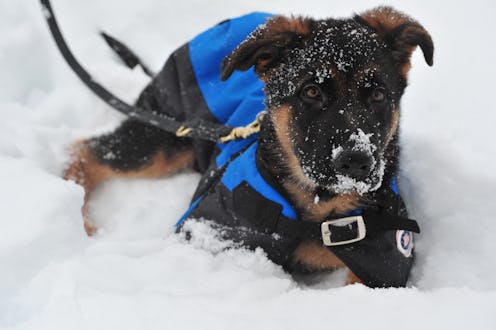News
Your Dog Might Have S.A.D. Too
The temperatures are below freezing. Your car is blocked into your driveway with no hope of escape. You're afraid you might break your ankle slipping on black ice. We all know this mess of winter-ness is making your life miserable — between the flu and the snowdrifts, this season isn't exactly a beach party — but have you ever stopped to think about how your pet might be feeling? After all, dog is (wo)man's best friend. It turns out that this year's extreme winter could be bumming out your pets, too — vets warn that the brutal winter can make your dog depressed.
According to animal experts, a significant percentage of dogs experience something akin to seasonal affective disorder (SAD). SAD — an apt acronym for the emotions it elicits in sufferers — affects anywhere from five to 10 percent of the American (human) population. If you have the disorder, you might find yourself depressed, excessively sleepy, unable to concentrate, and ceaselessly craving carbs. SAD throws off your circadian rhythm, more commonly called your biological clock. The lack of sunlight can disrupt your internal clock, making you feeling less optimistic about life and wishing you could nap more.
You may recognize these symptoms in yourself, but what about the most important member of the family — your dog? Without a healthy daily dose of sunlight, Fido might be slipping into SAD-ness. Check out the three warning signs below and find out how you can help your pup make it through the long, cold winter.
Symptom: Sluggishness
Every dog needs a nap once in a while, but if you notice your best friend is lazing around more often than not and never wants to get up and play, it might be time to hold an intervention.
Solution: Light box
Studies show that just as the lack of sun during the wintertime can bring you down, so can it wear down your dog. Scientists have known for years that bright light therapy can help alleviate symptoms of depression and SAD. There are even companies devoted to selling light boxes, which project white light that is supposed to cheer you up by imitating natural light. And this month, British travel company First Great Western paired up with the Seasonal Affective Disorder Association to demo the first "therapy train." The new train is equipped with Lumie light boxes to help commuters through the dark winter days.
Now you can get a light box designed especially for your dog. Pawsitive Lighting encourages pet owners to help their companions "see the light." The lights start from $99.99 and are currently sold out — but you can get a regular light box on Amazon.
Symptom: Unhealthy Appetite
According to researchers, many animals have a pineal gland at the base of the brain that responds negatively to underexposure to sunlight. This is the gland that tells bears to stuff their faces before hibernating all winter, and it's the same one that tells us — and our pets — to do more or less the same. Overeating can be symptomatic of depression and boredom in your pet, and it can inhibit his ability to get up and play, therefore inhibiting his own happiness and creating a terrible cycle of SAD.
Solution: Exercise
It's not too late yet! Even if your pup can't get outside for a nice long walk without burning his little feet on the salt and freezing his tail off, you can help him play indoors. Have a game of tug-of-war, throw around a toy, or plop him on the treadmill.
Symptom: Hair loss
Your dog doesn't get as much melatonin as his body needs during the winter because of the lack of sunlight. This doesn't just affect his mood, but it can hurt his coat, too. Some dogs can experience seasonal aloepecia, which can be not only embarrassing and unpleasant for your pet, but also not that cute to look at for you.
Solution: Take a trip
A change of scenery might be just what your dog needs. If you can, try to take a road trip — canines love cars — somewhere sunny. (The primary method of treatment for seasonal aloepecia is light box therapy, but it's even better if you can give your pet the real thing.)
Images: Giphy
